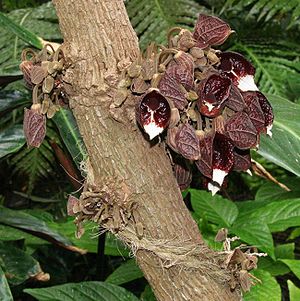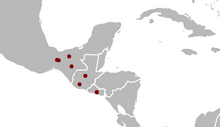Aristolochia arborea
| Aristolochia arborea | ||||||||||||
|---|---|---|---|---|---|---|---|---|---|---|---|---|

Aristolochia arborea |
||||||||||||
| Systematics | ||||||||||||
|
||||||||||||
| Scientific name | ||||||||||||
| Aristolochia arborea | ||||||||||||
| Linden trees |
Aristolochia arborea , sometimes referred to as tree-like pipe flower in German, is a species of pipe flower ( Aristolochia ) that occurs in the undergrowth of tropical rainforests in southern Mexico , Guatemala and El Salvador . Like other Aristolochia species, the flowers form a complex cauldron trap and act as a deceptive flower to attract pollinators. Aristolochia arborea imitatesthe fruiting body of a mushroom to attract fungus mosquitoes inside the flower envelope through its smell and a unique three-dimensional dummy. Since only seven localities of this species are known, it is believed to be very rare and possibly critically endangered. However, it iscultivatedin a number of botanical gardens .
features
Habit and leaves
Aristolochia arborea grows as an upright shrub or small tree with a richly branched trunk. The stature height is usually about two, at most five to six meters. The young branches are densely tomentose with fine, close-fitting, brownish trichomes . Older branches have thick, corked , cracked bark . The leaves sit on about one centimeter long, strong petioles , have entire margins and are relatively variable in shape, from egg-shaped to oblong to lanceolate-oblong. It lacks false secondary leaves, in contrast to many other species of the genus. The base is obliquely rounded, blunt or slightly pointed, the tip of the leaf is pointed. The leaves reach a length of 20 to 35 centimeters and a width of 4 to 15 centimeters. Their upper side is dark green and smooth, the underside is densely covered with thin, rust-brown hairs, especially along the leaf veins. The leaf veins run from the midrib approximately parallel to the leaf margin.
blossoms
The flowers sit directly on the trunk ( cauliflora ) below the deepest leaves. They are arranged in grape-like , richly branched groups with bracts and have kneeling flower stalks. The inflorescence is purple, densely hairy and about eight to nine centimeters long. The outside is dirty brown-red due to the translucent red color on the inside and the thick, brownish hair. The front part of the flower cover is wide, inverted heart-shaped with three, each 2.5 to 3 centimeters wide and 3 to 4 centimeters long, downward-pointing lobes that curl sharply outwards towards the edge. In the middle of this outer shell is the opening to the flower tube, in front of which sits a fine, downy, glandular hump, which carries a distended head on a stem. Its underside is white and the middle lobe of the flower envelope is also colored white, so that the imitation of the fruiting body of a mushroom of the genus Marasmius from the family of vertigo relatives , as well as the underlying mycelium, is created. The tube behind this hump is brownish, striped lengthways, inflated, curved, ovate and about 2 inches long. It bends sharply downwards directly behind the entrance and then bends vertically upwards to the sternum and stamen column . This is only indistinctly three-part and surrounded by six regularly arranged anthers . The ovary is subordinate.
fruit
The fruits are woody, slightly curved, club-shaped and hexagonal in cross-section capsules which reach a length of ten to fifteen, and a width of 1.5 to 2.5 centimeters. They are shiny green and hairy thickly brownish. About five to six months after pollination, they disintegrate from the tip into six parts and release about 60 seeds that sit in dense rows in the fruit. The seeds are heart-shaped, about an inch long and 0.8 inches wide, and surrounded by an elaiosome about twice as large .
Occurrence
There are only reports of seven localities of Aristolochia arborea in nature, so that it is generally assumed that the species is very rarely or already extinct in the wild, with the decline of the Central American rainforests being the main threat to the species. The species was found in southern Mexico in the states of Veracruz , Tabasco and Chiapas , as well as in Guatemala and El Salvador . This distribution area was a refuge for tropical vegetation in the late Pleistocene . The known specimens were found in the undergrowth of moist rainforest slopes at an altitude of 350 to 1250 meters.
Flower and fruit ecology
Aristolochia arborea sets numerous flowers with short interruptions throughout the year. The pollination has not yet been studied in the wild. Under greenhouse conditions it was observed that the three scar flaps stick together shortly after their unfolding due to the drying up of the scar secretion. In addition, the anthers open before the flower opens and becomes accessible to possible pollinators. In this way cross-pollination is prevented and self-pollination can only occur occasionally and then accidentally, which can also lead to seed set due to the lack of self-incompatibility . It was assumed that the flower development observed did not correspond to that at the natural location and could possibly be due to unfavorable environmental conditions in the culture, such as unsuitable humidity.
The eye-catching flowers represent an effective mushroom mimesis , which can be used to attract fungus gnats, which normally lay their eggs on the fruiting body of mushrooms. The slightly camphor-like , spicy smell, which is reminiscent of that of the common hazel root ( Asarum europaeum ), probably also plays a role here . During the examination of the dummy fungus, the female mosquitoes slide over the smooth-cell entrance into the basin behind. It is therefore believed that the flowers of Aristolochia arborea function as effective cauldron traps similar to those of other Aristolochia species . Since the scar column at the upper end of the boiler tube is surrounded by a ring of translucent cells, the captured animals try to escape here and could dump pollen on the surface of a scar column ready to receive. The flowers are proterogynous , so that the male organs only mature after the scars and release their pollen, which then trickles down onto the mosquitoes that have been caught. When the flower wilts, the fungus mosquitoes can escape again and - loaded with pollen - be attracted by another flower.
The seeds of Aristolochia arborea are probably carried away by ants that use the elaiosome as a source of food, and spread in this way ( myrmecochory ). This could be observed with several species of ants in greenhouse experiments. The plants germinate after four weeks to three months, with the cotyledon stalks lengthening rapidly, while the cotyledons remain in the seed coat and do not break free from it, or only when the primary leaves are already formed.
Systematics
Aristolochia arborea is classified according to the classification by OC Schmidt (1935) in the subgenus and section Siphisina . According to the revision by H. Huber (1985), who divides the genus Aristolochia into several genera, Aristolochia arborea is assigned as Isotrema arborea to the genus Isotrema and there to the subgenus Isotrema . Molecular biological studies support the assignment to Isotrema and indicate that Aristolochia salvadorensis is the sister species and that these two species together with Aristolochia tricaudata and Aristolochia paracleta form a Central American family group. Like all Isotrema species, Aristolochia arborea has a diploid chromosome set of 16 pairs (2n = 32).
Botanical history
The species was the first time of the Luxembourgish - Belgian botanist Jean Linden in 1858 in his Catalog des Plantes exotiques described , where he offered the kind for sale. He had received them from the collector Ghiesbrecht, who found them in Chiapas (Mexico). Another collector named Broadway reported cultivated specimens in Trinidad . A more detailed description was given in 1862 in Kew Gardens by Joseph Dalton Hooker in Curtis's Botanical Magazine . The plant has also been present in the botanical garden of Bogor (Indonesia) since at least the beginning of the twentieth century , from where a cutting was imported into the Bonn Botanical Garden . Further cuttings from the Bonn specimens were passed on to various botanical gardens, so that all plants in culture in Europe today may be clones of a specimen from Bogor. It is not known where this originally came from. Due to its self-compatibility, the species can also be easily propagated by opening the flowers and artificial pollination, but this has only been practiced since the end of the twentieth century. Breeding in and passing on between botanical gardens is considered to be important for the conservation of the species due to its rarity in the open air.
literature
- Christoph Neinhuis , Dieter Roth, Wilhelm Barthlott: Aristolochia arborea: The Biology and Thread of a Remarkable Rain Forest Tree from Central America . In: The palm garden . tape 58 , no. 1 , p. 15–19 (English, full text (English) / German translation at the Bonn Botanical Garden ).
- Howard W. Pfeifer: Revision of the North and Central American Hexandrous Species of Aristolochia (Aristolochiaceae) . In: Annals of the Missouri Botanical Garden . Volume 53, No. 2 , 1966, p. 115–196 , doi : 10.2307 / 2394940 (English, full text at the Biodiversity Heritage Library ).
- Paul C. Standley, Julian A. Steyermark: Flora of Guatemala . In: Fieldiana Botany . tape 24 , no. 4 , 1946, pp. 95 (English, full text at the Biodiversity Heritage Library ).
- H. Cammerloher: Infertility as a result of temporary Kleistopetalie in Aristolochia arborea. In: Reports of the German Botanical Society . tape 40 , 1922, pp. 385–393 (English, full text at the Biodiversity Heritage Library ).
Individual evidence
- ^ A b Howard W. Pfeifer: Revision of the North and Central American Hexandrous Species of Aristolochia (Aristolochiaceae). In: Annals of the Missouri Botanical Garden , Volume 53, Number 2, 1966. p. 134.
- ^ A b c Paul C. Standley, Julian A. Steyermark: Flora of Guatemala . In: Fieldiana Botany . tape 24 , no. 4 , 1946, pp. 95 (English).
- ↑ a b c d e Christoph Neinhuis, Dieter Roth, Wilhelm Barthlott: Aristolochia arborea: The Biology and Thread of a Remarkable Rain Forest Tree from Central America . In: The palm garden . tape 58 , no. 1 , p. 15-19 (English).
- ↑ a b c d H. Cammerloher: Infertility as a result of temporary Kleistopetalie in Aristolochia arborea. In: Reports of the German Botanical Society . tape 40 , 1922, pp. 385-393 .
- ↑ a b Jose Ortega Ortiz: Dos nuevos registros de Aristolochia (Aristolochiaceae) para Veracruz, Mexico . In: Phytologia . tape 67 , no. 1 , 1989, pp. 94–99 (Spanish, full text at the Biodiversity Heritage Library (Spanish) ).
- ↑ a b c d Herwig Teppner: Experiences in ex-situ conservation in the Botanic Garden of the Institute of Botany of the University of Graz . In: Fritschiana . tape 39 , 2003, p. 1–22 ( full text [PDF; 444 kB ]). Full text ( memento of the original from March 15, 2007 in the Internet Archive ) Info: The archive link was inserted automatically and has not yet been checked. Please check the original and archive link according to the instructions and then remove this notice.
- ^ OC Schmidt: Aristolochiaceae . In: A. Engler, H. Harms (Ed.): The natural plant families . 2nd Edition. tape 16 b. Berlin 1935, p. 204-242 .
- ↑ H. Huber: Seed characteristics and structure of the Aristolochiaceen . In: Botanical year-books for systematics, plant history and plant geography . tape 107 , no. 1-4 , 1985, pp. 277-320 .
- ↑ Tetsuo Ohi-Toma, Takashi Sugawara, Hiroko Murata, Stefan Wanke, Christoph Neinhuis, Jin Murata: Molecular Phylogeny of Aristolochia sensu lato (Aristolochiaceae) based on Sequences of rbcL, matK, and phyA Genes, with Special Reference to Differentiation of Chromosome Numbers . In: Systematic Botany . tape 31 , no. 3 , 2006, p. 481-492 (English).
Web links
- Description at the Botanical Garden Vienna (PDF; 1.10 MB)




